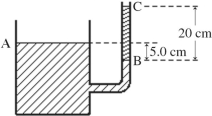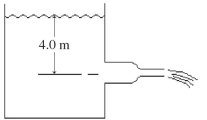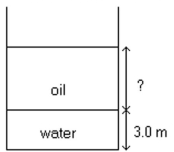A) 44.1 m/s
B) 17.64 m/s
C) 48.3 m/s
D) 4.20 m/s
F) A) and C)
Correct Answer

verified
Correct Answer
verified
Multiple Choice
Substance A has a density of 3 g/cm3 and substance Bhas a density of 4 g/cm3. In order to obtain equal masses of these two substances, what must be the ratio of the volume of A to the volume of
A)
B)
C)
D)
E)
G) A) and C)
Correct Answer

verified
Correct Answer
verified
Multiple Choice
A container has a vertical tube, whose inner radius is 20.00 mm, connected to it at its side, as shown in the figure. An unknown liquid reaches level A in the container and level B in the tube -level A being 5.0 cm higher than level B. The liquid supports a 20-cm high column of oil, between levels B and C , whose density is
The density of the unknown liquid is closest to

A)
B)
C)
D)
E)
G) None of the above
Correct Answer

verified
Correct Answer
verified
Multiple Choice
For a certain patient, the build-up of fatty tissue on the wall of an artery has decreased the arterial radius by 10%. By how much would the pressure provided by the heart have to be increased to maintain a constant volume of blood flow? Model the blood as an ideal incompressible fluid.
A) 46%
B) 54%
C) 48%
D) 52%
F) A) and C)
Correct Answer

verified
Correct Answer
verified
Multiple Choice
When a container of water is placed on a laboratory scale, the scale reads 120 g. Now a 20-g piece of copper is suspended from a thread and lowered into the water, not touching the bottom of the container. What will the scale now read? The density of water is 1.0
A) 120 g
B) 138 g
C) 122 g
D) 140 g
F) A) and C)
Correct Answer

verified
Correct Answer
verified
Multiple Choice
Water flows out of a large reservoir through 5.0-cm diameter pipe. The pipe connects to a 3.0-cm diameter pipe that is open to the atmosphere, as shown in the figure. What is the speed of the water in the 5.0-cm pipe? Treat the water as an ideal incompressible fluid.

A) 3.9 m/s
B) 10 m/s
C) 2.3 m/s
D) 8.9 m/s
E) 3.2 m/s
G) C) and D)
Correct Answer

verified
Correct Answer
verified
Multiple Choice
A 100-kg person sits on a 5-kg bicycle. The total weight is borne equally by the two wheels of the bicycle. The tires are 2.0 cm wide and are inflated to a gauge pressure of What length of each tire is in contact with the ground?
A) 1.6 cm
B) 2.4 cm
C) 1.8 cm
D) 6.4 cm
E) 3.2 cm
G) C) and E)
Correct Answer

verified
Correct Answer
verified
Multiple Choice
A hot air balloon along with its cargo has a mass of and it holds of hot air. It is floating at a constant height in air with a density of What is the density of the hot air in the balloon?
A)
B)
C)
D)
E)
G) A) and D)
Correct Answer

verified
Correct Answer
verified
Multiple Choice
Ideal incompressible water flows through a horizontal pipe of cross-sectional area at a pressure of 0.250 atm with a volume flow rate of At a valve, the effective cross-sectional area of the pipe is reduced to What is the pressure at the valve?
A) 0.235 atm
B) 0.112 atm
C) 0.200 atm
D) 0.157 atm
F) C) and D)
Correct Answer

verified
Correct Answer
verified
Short Answer
As shown in the figure, a large open tank contains a layer of oil
floating on top of a layer of water
that is 3.0 m thick, as shown in the sketch. What must be the thickness of the oil layer if the gauge pressure at the bottom of the tank is to be

Correct Answer

verified
Correct Answer
verified
Multiple Choice
An incompressible ideal fluid flows steadily through a pipe that has a change in diameter. The fluid speed at a location where the pipe diameter is 8.0 cm is 1.28 m/s . What is the fluid speed at a location where the diameter has narrowed to 4.0 cm?
A) 5.1 m/s
B) 2.6 m/s
C) 0.32 m/s
D) 0.64 m/s
E) 1.3 m/s
G) C) and E)
Correct Answer

verified
Correct Answer
verified
Multiple Choice
A solid object floats in water with three-fourths of its volume beneath the surface. What is the object's density? The density of water is
A)
B)
C)
D)
F) B) and C)
Correct Answer

verified
Correct Answer
verified
Multiple Choice
Water, which we can treat as ideal and incompressible, flows at 12 m/s in a horizontal pipe with a pressure of If the pipe widens to twice its original radius, what is the pressure in the wider section?
A)
B)
C)
D)
F) A) and B)
Correct Answer

verified
Correct Answer
verified
Multiple Choice
A cubical block of stone is lowered at a steady rate into the ocean by a crane, always keeping the top and bottom faces horizontal. Which one of the following graphs best describes the absolute (total) pressure p on the bottom of this block as a function of time t if the block just enters the water at time t = 0 s?
A) ![]()
B) ![]()
C) ![]()
D) ![]()
E) ![]()
G) A) and D)
Correct Answer

verified
Correct Answer
verified
Short Answer
A brick weighs 50.0 N, and measures What is the maximum pressure it can exert on a horizontal surface due to its weight?
Correct Answer

verified
Correct Answer
verified
Multiple Choice
Water is flowing in a drainage channel of rectangular cross-section. The width of the channel is 15 m, the depth of water is 8.0 m, and the speed of the flow is 2.5 m/s. What is the mass flow rate of the water? The density of water is
A)
B)
C)
D)
E)
G) C) and D)
Correct Answer

verified
Correct Answer
verified
Multiple Choice
A 1938 nickel has a diameter of 21.21 mm, a thickness of 1.95 mm, and weighs 0.04905 N. What is its density?
A)
B)
C)
D)
E)
G) None of the above
Correct Answer

verified
Correct Answer
verified
Multiple Choice
If a ship has a mass of 10 million kilograms, what volume of fresh water must it displace in order to float? The density of water is
A)
B)
C)
D)
E)
G) A) and B)
Correct Answer

verified
Correct Answer
verified
Multiple Choice
A 13,000-N vehicle is to be lifted by a 25-cm diameter hydraulic piston. What force needs to be applied to a 5.0 cm diameter piston to accomplish this? Assume the pistons each have negligible weight.
A) 5200 N
B) 520 N
C) 2600 N
D) 260 N
F) A) and B)
Correct Answer

verified
Correct Answer
verified
Multiple Choice
A 4.7-kg solid sphere, made of metal whose density is hangs by a light cord. When the sphere is immersed in water, what is the tension in the cord? The density of water is 1000
A) 46 N
B) 58 N
C) 35 N
D) 52 N
E) 40 N
G) A) and C)
Correct Answer

verified
Correct Answer
verified
Showing 61 - 80 of 98
Related Exams